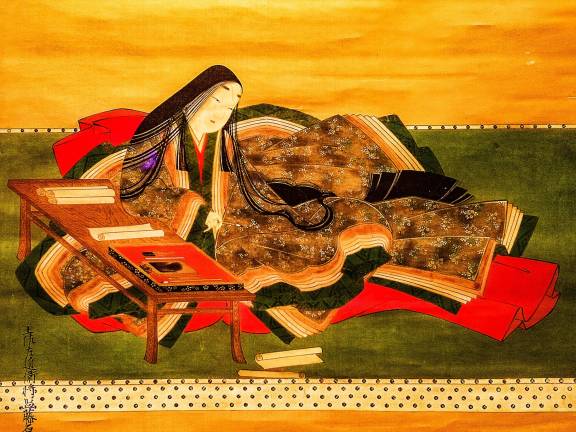the enduring legacy of a masterpiece

Countless people have read “The Tale of Genji.” the renowned classic of Japanese literature, but a show at the Met, running through June 16th, is the first exhibition in the United States devoted to artworks the story has inspired. Over 120 paintings, screens, calligraphic works, lacquer wares, book covers, and even kimonos that depict, respond to, protect, and celebrate the epic tale are on view. Many are on loan from important international collections and haven’t been seen in New York before. Two have been designated as National Treasures in Japan.
Japan’s ShakespeareWhen Murasaki Shikibu, a Japanese noblewoman of the early 11th century, penned her tales of court intrigue, love, loss and life, she did many things no one had done before, which is why “Genji” is considered the world’s first novel. She created an art form that redefined literature. She fashioned characters and scenes that would be loved for a thousand years. She, a woman, authored one of the most enduring, influential works of art in human history. No one told her she couldn’t or shouldn’t. And, as seen in the works on view at the Met, which span from the Middle Ages to the 21st century, she inspired generation upon generation of artists.
Lady Murasaki is, in a way, Japan’s Shakespeare. Her masterpiece “Genji” is an epic poem, so grand that the paperback translation on our bookshelf clocks in at close to 1100 pages. Its 54 chapters illuminate aspects of court life, political machinations, human love and yearning, and Buddhist world views. And, as with Shakespeare, more people knew her stories than may have actually read them.
The archaic language is difficult for modern readers. But the tales are so known and loved that Murasaki and her characters have been portrayed by the preeminent Japanese artists of every era since their debut. Japan’s equivalent of Rembrandt painted references to Genji, as did its Picassos. Patrons who wished to align themselves with aspects of the tale, perhaps a nobleman in exile, or a lady of refinement, commissioned elegant artworks for their homes to proclaim their similar natures.
A Woman at WorkOne of the delights of the exhibition is the number of portraits of Lady Murasaki on view. She sits, alone at her desk, tirelessly writing, through the seasons or under moonlit skies. Murasaki’s great-grandfather and grandfather were poets. Her father was both poet and scholar of poetry, and her diary recounts lessons for her brother where she would listen and then surpass him. Writing and education for women were encouraged in Heian culture, and Murasaki’s erudition, diligence, and passion carried her to the court of Empress Shōshi, who surrounded herself with women writers and scholars.
Today’s artists still find inspiration in the author and her tale. Yamato Waki, a contemporary groundbreaking woman manga artist articulates Genji themes through the idiom of shōjo manga (girl’s comics). Selections from Waki’s multi-volume “Dreams at Dawn,” as well as a video showing her painting, are presented. And “Murasaki’s Moon,” a new opera commissioned by the Met, was performed last week in the Astor Court.
A Garden of DelightsThe exhibition, curated by the Met’s John T. Carpenter and Monika Bincsik, along with Melissa McCormick, a professor at Harvard, and Kyoko Kinoshita, professor at Tama Art University, plots a journey through the ages of Genji. It offers a gorgeous immersion into a fusion of Japanese arts, where literature, calligraphy, poetry, painting, sculpture, prints, textiles, decorative arts, music and video blossom individually, but together, to become a garden of delights.
From important spiritual works from Ishiyamadera Temple (where legend has it Murasaki began the novel), to masterworks of calligraphy, to Noh theater costumes, to 19th century woodblock prints and 21st century comic books, the lasting legacy of Lady Murasaki’s creation is breathtaking.